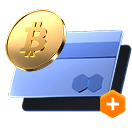Preço de USDC
USDCInformações do mercado de USDC
Preço ao vivo de USDC hoje em USD
Quanto vale 1 USDC em ?
Sobre USDC(USDC)
Histórico de preços de USDC
Por que o preço de USDC sempre oscila?
Quais fatores afetam o desempenho dos preços de USDC?
Preços globais de USDC
Como comprar USDC
Junte-se ao Toobit agora!
Cadastre-se na Toobit com seu e-mail/número de celular e país de residência e crie uma senha forte para proteger sua conta.
Verifique sua identidade
Complete a verificação de identidade enviando seus dados pessoais e um documento de identificação com foto válido.
Adicione um método de pagamento e compre USDC (USDC)
Adicione um cartão de crédito/débito ou conta bancária após verificar sua conta Toobit. Use várias opções de pagamento para comprar USDC na Toobit.
Negocie contratos futuros perpétuos de USDC
Após se cadastrar na Toobit e comprar USDT ou tokens USDC, você pode começar a fazer trade de Derivatives, incluindo futuros USDC e Margin trading para aumentar sua renda.
Participe do Copy Trading de USDC com Traders Líderes
Após se registrar na Toobit e comprar com sucesso USDT ou tokens USDC, você também pode começar o copy trading seguindo Traders Líderes.
Onde posso comprar USDC?
Compre cripto no app da Toobit
Cadastre-se em poucos minutos para comprar cripto via cartão de crédito ou transferência bancária.
Negocie na Toobit
Deposite suas criptomoedas na Toobit e aproveite alta liquidez e taxas de negociação baixas.
Seção de vídeo — verificação rápida, negociação rápida

Como concluir a identificação na Toobit e se proteger contra fraudes
- 1.Entre na sua conta Toobit.
- 2.Se você é novo na Toobit, assista ao nosso tutorial sobre como criar uma conta.
- 3.Clique no ícone de perfil no canto superior direito da barra de navegação e depois toque na página de Identificação.
Perguntas Frequentes Sobre USD Coin (USDC)
Quem criou e governa o USDC?
O USDC foi lançado através de uma colaboração entre a Circle e a Coinbase, duas empresas regulamentadas no espaço cripto. É governado pelo Centre Consortium, uma organização de membros que define os padrões técnicos, políticos e financeiros para a stablecoin. Esta estrutura ajuda a garantir confiança, transparência e conformidade dentro do ecossistema USDC.Para que é usado o USDC?
USD Coin (USDC) é uma stablecoin projetada para combinar a estabilidade do dólar americano com a velocidade e transparência da tecnologia blockchain. Atua como uma ponte entre as finanças tradicionais e o ecossistema cripto. Seus principais usos incluem:1. Meio de troca estável: O USDC mantém uma paridade de 1:1 com o dólar americano, tornando-o adequado para pagamentos, transferências peer-to-peer e compras online sem exposição às flutuações do mercado cripto. 2. Negociação e liquidez: Os traders usam o USDC como uma moeda base estável para gerenciar a volatilidade. Permite movimentação rápida entre ativos e é um par de negociação comum em várias exchanges, melhorando a liquidez. 3. Finanças descentralizadas (DeFi): O USDC é amplamente utilizado em plataformas DeFi como Aave, Compound e MakerDAO. Os usuários podem emprestar, tomar emprestado, fazer staking ou fornecer liquidez para ganhar rendimento com risco de preço mínimo. 4. Remessas e pagamentos: O USDC permite pagamentos globais rápidos e de baixo custo, reduzindo a necessidade de intermediários em transações transfronteiriças. 5. Proteção contra volatilidade: Os investidores convertem ativos cripto voláteis em USDC durante condições de mercado incertas para preservar o valor enquanto permanecem on-chain. 6. Tokens não fungíveis (NFTs) e jogos: Em marketplaces de NFT e jogos baseados em blockchain, o USDC fornece preços consistentes para ativos digitais e economias de jogos. 7. Pagamentos de contratos inteligentes: O USDC pode ser usado em pagamentos automatizados através de contratos inteligentes em blockchains como Ethereum, aumentando a transparência e eficiência para aplicações descentralizadas (dApps). Em resumo, a estabilidade, liquidez e interoperabilidade do USDC fazem dele uma ferramenta chave para pagamentos, negociação, DeFi e outras aplicações Web3.Como funciona o USDC?
USD Coin (USDC) é uma stablecoin atrelada 1:1 ao dólar americano, projetada para trazer o valor do dólar para o blockchain. Criada pela Circle e Coinbase, permite que os usuários armazenem e transfiram valor digitalmente sem a volatilidade vista na maioria das criptomoedas. Veja como funciona:• Atrelado ao dólar americano: Cada token USDC representa um dólar americano mantido em reserva. Para cada USDC emitido, uma quantia equivalente em USD ou ativos equivalentes a dinheiro é armazenada por instituições financeiras regulamentadas, garantindo total respaldo e transparência. • Emissão e resgate: Para cunhar USDC, os usuários depositam dólares americanos com um emissor aprovado (como a Circle), que então cria e envia a quantia equivalente de USDC para a carteira do usuário. Para resgatar USDC, os usuários enviam tokens de volta ao emissor, que devolve a quantia equivalente em USD e queima os tokens. • Funcionalidade cross-chain: O USDC opera em várias blockchains, incluindo Ethereum, Solana, Algorand, Stellar, Tron e Hedera. Isso permite transações rápidas, de baixo custo e interoperáveis entre diferentes redes. • Uso em transações digitais: O USDC mantém um valor estável, tornando-o adequado para pagamentos, remessas e aplicações DeFi. Os usuários podem transferir “dólares digitais” globalmente sem depender de bancos tradicionais. Em suma, o USDC combina a estabilidade da moeda fiduciária com a eficiência do blockchain, oferecendo um dólar digital transparente, seguro e versátil para indivíduos e instituições.Como o desempenho do preço do USDC se compara aos seus pares?
Nos últimos 7 dias, o USD Coin (USDC) manteve sua paridade com o dólar americano, mostrando uma variação de preço de 0,00%. Enquanto o mercado geral de criptomoedas aumentou 5,20%, o valor estável do USDC reflete seu propósito como um ativo não volátil projetado para estabilidade em vez de crescimento.Outras stablecoins subiram ligeiramente, cerca de 0,10%, mas o desempenho estável do USDC alinha-se com seu papel como um meio de troca confiável e reserva de valor no mercado cripto.Quantos USDC existem em circulação?
Não é possível fornecer um número exato de USDC em circulação porque o fornecimento ajusta-se com base na demanda do mercado. Novos tokens são cunhados ou queimados conforme necessário. O uso do USDC cresceu significativamente durante o boom das finanças descentralizadas (DeFi) em 2020, quando se tornou uma stablecoin preferida para usuários interagindo com protocolos DeFi e o ecossistema cripto mais amplo.USDC vs. USDT
USDC (USD Coin) e USDT (Tether) são ambos stablecoins atrelados ao dólar americano, mas diferem em transparência e regulamentação.USDC: Emitido pela Coinbase e Circle, o USDC é totalmente regulamentado e passa por auditorias regulares para garantir que cada token seja respaldado por reservas em dólares americanos. Isso o torna transparente e confiável. USDT: O Tether é a stablecoin mais amplamente usada, mas enfrentou questões sobre a transparência e suficiência de suas reservas.No geral, o USDC é geralmente visto como mais confiável devido à sua regulamentação e gestão clara de reservas, enquanto o USDT permanece popular para negociação e liquidez.Quais são os casos de uso para USDC e USDT?
Tanto o USD Coin (USDC) quanto o Tether (USDT) são stablecoins amplamente utilizados no ecossistema de criptomoedas com vários usos práticos:• Pagamentos transfronteiriços: Permitem transferências internacionais rápidas e de baixo custo.• Negociação: Ambos são suportados na maioria das exchanges de cripto, permitindo que os traders movam-se dentro e fora de posições com um valor estável.• Finanças descentralizadas (DeFi): USDC e USDT são usados em plataformas de empréstimo, exchanges descentralizadas (DEXs) e pools de liquidez.• Trocas de stablecoins: Os usuários podem trocar entre USDC e USDT em diferentes plataformas para aproveitar as condições de mercado.No geral, essas stablecoins fornecem uma maneira simples de armazenar valor, fazer transações e participar do ecossistema cripto.Como a taxa de câmbio do dólar americano afeta o preço do USDC?
USD Coin (USDC) é atrelado ao dólar americano, então mudanças na taxa de câmbio do dólar podem afetar o valor do USDC em relação a outras moedas.• Se o dólar americano se fortalecer, o USDC pode subir ligeiramente em relação a outras moedas para manter sua paridade.• Se o dólar americano enfraquecer, o USDC pode cair ligeiramente para continuar acompanhando o valor do dólar.No geral, o USDC é projetado para permanecer estável em relação ao dólar americano, ajustando-se conforme necessário para refletir mudanças na taxa de câmbio do dólar.Como a volatilidade geral do mercado afeta o preço do USDC?
USD Coin (USDC) é uma stablecoin atrelada ao dólar americano, então seu valor geralmente permanece em $1, ao contrário de criptomoedas como Bitcoin ou Ethereum. Cada USDC é totalmente respaldado por dinheiro ou ativos de curto prazo do Tesouro dos EUA, permitindo que seja resgatado por moeda fiduciária a qualquer momento.Impacto da volatilidade do mercado: • Durante períodos de alta volatilidade do mercado, os investidores frequentemente movem fundos para o USDC como uma opção segura. Essa demanda aumentada pode elevar o preço ligeiramente acima de $1, mas a arbitragem geralmente restaura a paridade rapidamente. • Quando a confiança aumenta e os fundos retornam a outros ativos, a demanda por USDC pode cair, ocasionalmente fazendo o preço cair ligeiramente abaixo de $1.Riscos principais para a paridade: • Mudanças regulatórias afetando emissores de stablecoins • Preocupações sobre a transparência das reservas de respaldo • Problemas bancários ou de liquidez que poderiam atrasar resgatesApesar desses riscos, o USDC mantém sua paridade através de governança, auditorias regulares e respaldo total de reservas, mantendo-o um ativo estável e confiável no ecossistema de criptomoedas.Vale a pena comprar USDC?
USD Coin (USDC) é uma stablecoin, então não é destinada como um investimento. Seu valor é atrelado ao dólar americano, o que significa que não aumenta como ativos tradicionais. No entanto, o USDC pode ser usado para ganhar renda passiva. Ao usar programas de empréstimo ou plataformas de finanças descentralizadas (DeFi), os usuários podem ganhar um rendimento percentual anual, às vezes acima de 5%.É importante ter cautela ao investir grandes quantias de USDC, pois os retornos dependem da plataforma e das condições de mercado.O USDC é seguro e regulamentado?
Sim. USD Coin (USDC) é considerado uma stablecoin regulamentada e segura. Suas reservas são mantidas em instituições financeiras dos EUA e estão sujeitas às leis e supervisão de transmissão de dinheiro dos EUA. Esta conformidade regulatória proporciona confiança aos usuários e instituições ao usar o USDC.Quais são os riscos de usar USDC?
Embora o USD Coin (USDC) seja geralmente considerado de baixo risco, os usuários devem estar cientes dos seguintes riscos potenciais:• Risco de contraparte: As instituições que mantêm as reservas do USDC podem falhar. Por exemplo, problemas com o Silicon Valley Bank em 2023 levaram a Circle a mudar para um sistema bancário mais estável. • Risco regulatório: Mudanças nas regulamentações de criptomoedas podem afetar o uso e emissão de stablecoins. • Risco de contrato inteligente: Vulnerabilidades podem existir no código blockchain onde o USDC opera. • Risco de desvalorização: Eventos de mercado raros podem temporariamente fazer o USDC se afastar de sua paridade de $1, embora os mecanismos de resgate geralmente o restaurem rapidamente.Quão transparentes são as reservas do USDC?
USD Coin (USDC) é conhecido por sua transparência. Suas reservas são mantidas em dinheiro e títulos do Tesouro dos EUA de curto prazo. A Circle publica relatórios de atestação mensais da firma de contabilidade independente Grant Thornton. Esses relatórios verificam que as reservas respaldam totalmente todos os tokens USDC em circulação, proporcionando confiança e responsabilidade aos usuários.Quem criou e governa o USDC?
O USDC foi lançado através de uma colaboração entre a Circle e a Coinbase, duas empresas regulamentadas no espaço cripto. É governado pelo Centre Consortium, uma organização de membros que define os padrões técnicos, de política e financeiros para a stablecoin. Esta estrutura ajuda a garantir confiança, transparência e conformidade dentro do ecossistema USDC.Para que é usado o USDC?
USD Coin (USDC) é uma stablecoin projetada para combinar a estabilidade do dólar americano com a velocidade e transparência da tecnologia blockchain. Atua como uma ponte entre as finanças tradicionais e o ecossistema cripto. Seus principais usos incluem:1. Meio de troca estável: O USDC mantém uma paridade de 1:1 com o dólar americano, tornando-o adequado para pagamentos, transferências peer-to-peer e compras online sem exposição às flutuações do mercado cripto.2. Negociação e liquidez: Os traders usam o USDC como uma moeda base estável para gerenciar a volatilidade. Permite movimentação rápida entre ativos e é um par de negociação comum em várias exchanges, melhorando a liquidez.3. Finanças descentralizadas (DeFi): O USDC é amplamente utilizado em plataformas DeFi como Aave, Compound e MakerDAO. Os usuários podem emprestar, tomar emprestado, fazer staking ou fornecer liquidez para ganhar rendimento com risco de preço mínimo.4. Remessas e pagamentos: O USDC permite pagamentos globais rápidos e de baixo custo, reduzindo a necessidade de intermediários em transações transfronteiriças.5. Proteção contra volatilidade: Os investidores convertem ativos cripto voláteis em USDC durante condições de mercado incertas para preservar valor enquanto permanecem on-chain.6. Tokens não fungíveis (NFTs) e jogos: Em marketplaces de NFTs e jogos baseados em blockchain, o USDC fornece preços consistentes para ativos digitais e economias de jogos.7. Pagamentos de contratos inteligentes: O USDC pode ser usado em pagamentos automatizados através de contratos inteligentes em blockchains como Ethereum, aumentando a transparência e eficiência para aplicativos descentralizados (dApps).Em resumo, a estabilidade, liquidez e interoperabilidade do USDC fazem dele uma ferramenta chave para pagamentos, negociação, DeFi e outras aplicações Web3.Como funciona o USDC?
USD Coin (USDC) é uma stablecoin atrelada 1:1 ao dólar americano, projetada para trazer o valor do dólar para o blockchain. Criada pela Circle e Coinbase, permite que os usuários armazenem e transfiram valor digitalmente sem a volatilidade vista na maioria das criptomoedas. Veja como funciona:• Atrelada ao dólar americano: Cada token USDC representa um dólar americano mantido em reserva. Para cada USDC emitido, uma quantia equivalente em USD ou ativos equivalentes a dinheiro é armazenada por instituições financeiras regulamentadas, garantindo total respaldo e transparência.• Emissão e resgate: Para cunhar USDC, os usuários depositam dólares americanos com um emissor aprovado (como a Circle), que então cria e envia a quantia equivalente de USDC para a carteira do usuário. Para resgatar USDC, os usuários enviam tokens de volta ao emissor, que devolve a quantia equivalente em USD e queima os tokens.• Funcionalidade entre cadeias: O USDC opera em múltiplos blockchains, incluindo Ethereum, Solana, Algorand, Stellar, Tron e Hedera. Isso permite transações rápidas, de baixo custo e interoperáveis entre diferentes redes.• Uso em transações digitais: O USDC mantém um valor estável, tornando-o adequado para pagamentos, remessas e aplicações DeFi. Os usuários podem transferir “dólares digitais” globalmente sem depender de bancos tradicionais.Em resumo, o USDC combina a estabilidade da moeda fiduciária com a eficiência do blockchain, oferecendo um dólar digital transparente, seguro e versátil para indivíduos e instituições.Como o desempenho do preço do USDC se compara com seus pares?
Nos últimos 7 dias, o USD Coin (USDC) manteve sua paridade com o dólar americano, mostrando uma variação de preço de 0,00%. Enquanto o mercado geral de criptomoedas aumentou 5,20%, o valor estável do USDC reflete seu propósito como um ativo não volátil projetado para estabilidade em vez de crescimento.Outras stablecoins subiram ligeiramente, cerca de 0,10%, mas o desempenho estável do USDC está alinhado com seu papel como um meio de troca confiável e reserva de valor no mercado de criptomoedas.Quantos USDC estão em circulação?
Não é possível fornecer um número exato de USDC em circulação porque o fornecimento se ajusta com base na demanda do mercado. Novos tokens são criados ou queimados conforme necessário. O uso do USDC cresceu significativamente durante o boom das finanças descentralizadas (DeFi) em 2020, quando se tornou uma stablecoin preferida para usuários que interagem com protocolos DeFi e o ecossistema cripto mais amplo.USDC vs. USDT
USDC (USD Coin) e USDT (Tether) são ambos stablecoins atrelados ao dólar americano, mas diferem em transparência e regulação.USDC: Emitido pela Coinbase e Circle, o USDC é totalmente regulamentado e passa por auditorias regulares para garantir que cada token seja respaldado por reservas em dólares americanos. Isso o torna transparente e confiável. USDT: O Tether é o stablecoin mais amplamente utilizado, mas enfrentou questões sobre a transparência e suficiência de suas reservas.No geral, o USDC é geralmente visto como mais confiável devido à sua regulamentação e gestão clara de reservas, enquanto o USDT continua popular para negociação e liquidez.Quais são os casos de uso para USDC e USDT?
Tanto o USD Coin (USDC) quanto o Tether (USDT) são stablecoins amplamente utilizados no ecossistema de criptomoedas com vários usos práticos:• Pagamentos transfronteiriços: Permitem transferências internacionais rápidas e de baixo custo.• Negociação: Ambos são suportados na maioria das exchanges de criptomoedas, permitindo que os traders movam-se dentro e fora de posições com um valor estável.• Finanças descentralizadas (DeFi): USDC e USDT são usados em plataformas de empréstimo, exchanges descentralizadas (DEXs) e pools de liquidez.• Trocas de stablecoins: Os usuários podem trocar entre USDC e USDT em diferentes plataformas para aproveitar as condições de mercado.No geral, essas stablecoins oferecem uma maneira simples de armazenar valor, realizar transações e participar do ecossistema cripto.Como a taxa de câmbio do dólar americano afeta o preço do USDC?
O USD Coin (USDC) está atrelado ao dólar americano, portanto, mudanças na taxa de câmbio do dólar podem afetar o valor do USDC em relação a outras moedas.• Se o dólar americano se valorizar, o USDC pode subir ligeiramente em relação a outras moedas para manter sua paridade.• Se o dólar americano se desvalorizar, o USDC pode cair ligeiramente para continuar acompanhando o valor do dólar.No geral, o USDC é projetado para permanecer estável em relação ao dólar americano, ajustando-se conforme necessário para refletir as mudanças na taxa de câmbio do dólar.Como a volatilidade geral do mercado afeta o preço do USDC?
USD Coin (USDC) é uma stablecoin atrelada ao dólar americano, portanto, seu valor geralmente permanece em $1, ao contrário de criptomoedas como Bitcoin ou Ethereum. Cada USDC é totalmente respaldado por dinheiro ou ativos de curto prazo do Tesouro dos EUA, permitindo que seja resgatado por moeda fiduciária a qualquer momento.Impacto da volatilidade do mercado: • Durante períodos de alta volatilidade do mercado, os investidores frequentemente movem fundos para o USDC como uma opção segura. Essa demanda aumentada pode elevar o preço ligeiramente acima de $1, mas a arbitragem geralmente restaura o valor rapidamente. • Quando a confiança aumenta e os fundos retornam a outros ativos, a demanda por USDC pode cair, ocasionalmente fazendo o preço cair ligeiramente abaixo de $1.Principais riscos para o valor: • Mudanças regulatórias que afetam os emissores de stablecoins • Preocupações sobre a transparência das reservas de respaldo • Problemas bancários ou de liquidez que possam atrasar os resgatesApesar desses riscos, o USDC mantém seu valor através de governança, auditorias regulares e respaldo total das reservas, mantendo-se um ativo estável e confiável no ecossistema de criptomoedas.Vale a pena comprar USDC?
USD Coin (USDC) é uma stablecoin, portanto, não é destinada a investimento. Seu valor está atrelado ao dólar americano, o que significa que não aumenta como ativos tradicionais. No entanto, o USDC pode ser usado para gerar renda passiva. Ao usar programas de empréstimo ou plataformas de finanças descentralizadas (DeFi), os usuários podem obter um rendimento percentual anual, às vezes superior a 5%.É importante ter cautela ao investir grandes quantias em USDC, pois os retornos dependem da plataforma e das condições de mercado.O USDC é seguro e regulamentado?
Sim. O USD Coin (USDC) é considerado uma stablecoin regulamentada e segura. As suas reservas são mantidas em instituições financeiras dos EUA e estão sujeitas às leis de transmissão de dinheiro dos EUA e supervisão. Este cumprimento regulatório proporciona confiança aos usuários e instituições ao utilizar o USDC.Quais são os riscos de usar USDC?
Embora o USD Coin (USDC) seja geralmente considerado de baixo risco, os usuários devem estar cientes dos seguintes riscos potenciais:• Risco de contraparte: As instituições que mantêm reservas de USDC podem falhar. Por exemplo, problemas com o Silicon Valley Bank em 2023 levaram a Circle a mudar para um sistema bancário mais estável. • Risco regulatório: Mudanças nas regulamentações de criptomoedas podem afetar o uso e a emissão de stablecoins. • Risco de contrato inteligente: Podem existir vulnerabilidades no código blockchain onde o USDC opera. • Risco de desvalorização: Eventos de mercado raros podem temporariamente fazer com que o USDC se afaste de sua paridade de $1, embora os mecanismos de resgate geralmente o restaurem rapidamente.Quão transparentes são as reservas do USDC?
O USD Coin (USDC) é conhecido por sua transparência. Suas reservas são mantidas em dinheiro e em títulos do Tesouro dos EUA de curto prazo. A Circle publica relatórios de atestação mensais da empresa de contabilidade independente Grant Thornton. Esses relatórios verificam que as reservas respaldam totalmente todos os tokens USDC em circulação, proporcionando aos usuários confiança e responsabilidade.


